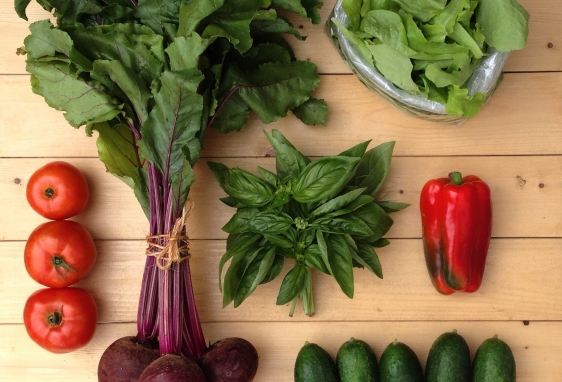Courtesy of Jared Regier, Chain Reaction Urban Farm, Saskatoon SK
Every bit of advice I encountered about starting a farm suggested not starting with any kind of CSA program in the first year. I did it anyway because it just seemed like the right fit for our farm scale and values. The SPIN system gave us the confidence to dive in.
We knew that to keep our members happy, we had to have steady production and a balance of crop selection to harvest throughout the season, but accomplishing this is a challenge. When the average gardener thinks about growing a tomato, they start with the tomato seed. CSA farmers start with the tomato sale. This shift in mindset makes all the difference. In order to plan effectively, we need to start with the end result and work backwards. Anyone can follow the same algorithm if you know your weekly box value, your units of sale (ie,1/2lb bag of lettuce for $5), and your expected yields per standard bed. Just layout a new spreadsheet and follow the steps below:
1. Decide on the weekly and total value you want to offer your members for the season.
This year, we decided on a $35 weekly value for our Standard Share memberships and we will offer this for a 15 week season from the first week of July to mid October. That leaves us with a membership price of $525.
2. Determine the contents of the first of your weekly boxes and be specific.
Write down the quantity and value of each crop that each box will contain. Most of our units are $5.00, so I generally need a combination of about 7 items per week.
3. Repeat #2 for each of the remaining weeks of the season.
Change the combinations as you expect new crops to be ready for harvest. Your members will appreciate your boxes more if you consider combinations that would work well for meal preparation.
4. For each crop, total the units of production needed for the entire season for one member.
This will show you both the quantity of crop you need to produce and the value of each crop your members will be receiving. For example, I can see that out of the $525 total share price, $40 will go towards 8 lbs of heirloom tomatoes.
5. Decide how many members you would like to serve and calculate your total production needed for each crop.
If you don’t know, do the math for 10 or 20 and see what things look like. Just multiply all of the totals by 10. This step is simple, but important because it transforms your quantities into numbers that are on the same scale as your standard bed production numbers. If 10 members all need 8 lbs of tomatoes, I need 80 lbs in total.
6. Determine the number of standard beds you need to plant for each crop using your crop totals and the expected yield per standard bed.
For example, with tomatoes I can calculate that based on at least 100 lbs of production per 50 sq ft bed, I will need 0.8 of a bed to serve 10 members. I always round up to make the math easy and for a bit of production insurance. The SPIN 18 guide is extremely helpful for this stage!
7. Add up all of the beds to determine the total number of beds you would need for 10 members.
That’s it. Do you have enough land? Can you add another 10 members? Can you adjust your crop proportions to make better use of your land base?
Need help with your crop planning? Then join our network and pick the brains of the most successful backyard farmers today – like Jared.


